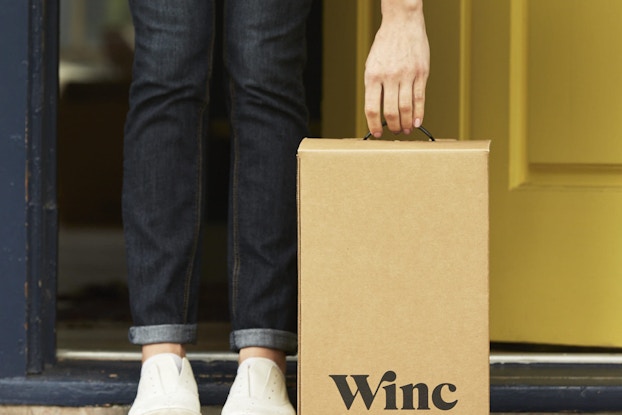
Winc is seeking to enhance the wine-buying experience by applying consumer feedback and other variables to its winemaking and marketing processes.
The Los Angeles-based subscription wine club, which was founded in 2012, differentiates itself from other wine subscription box services through the vertical management of its wine production. Rather than buying third-party wines and reselling them, Winc makes its own wines and markets them under its own brands.
The direct-to-consumer brand makes all of its products, “from grapes to glass,” owning the production, branding and distribution.
The company sources its grapes from all over the world, and then oversees the production itself, mostly from facilities in California.
Subscriptions start at $39, plus $9 for shipping, to receive three bottles of wine each month. Wines are suggested for subscribers based on their responses to Winc’s “Palate Profile Quiz” — a survey that helps Winc discern consumers’ likely wine preferences — and their ratings of past purchases. Customers can also add bottles to their orders, and, by purchasing four or more bottles, earn free shipping.
“A lot of people love wine, and we’ve been able to deliver on that for a variety of different demographics,” Lindsey Knowles, vice president of marketing at Winc, told CO—.

Winc vies for market share among an increasing array of wine subscription services, such as Firstleaf and Bright Cellars, along with new subscription wine offerings from meal kit companies such as Hello Fresh, in addition to competing against traditional retailers.
While the vast majority of wine sales in the U.S. go through distributors to end up in restaurants or on retail shelves, many smaller wineries have for several years now been adopting direct-to-consumer sales through their own tasting rooms and wine clubs. In fact, 60% of sales at small-scale wineries are now made directly to consumers, Rob McMillan, executive vice president and founder of Silicon Valley Bank’s Wine Division, told CO—.
“If you can figure out a way to get wine direct to consumers, you’ve got something,” he said.
Market challenges
Direct-to-consumer strategies face several challenges, however, including the fact that wine bottles are relatively heavy, making shipping more expensive, McMillan pointed out.
Meanwhile, the $14 billion U.S. wine industry is cycling out of a 24-year run of robust growth, fueled by higher consumption and premium pricier offerings, just as the Baby Boomer generation entered their peak spending years, the report found. But while total dollar sales of wine in the U.S., the largest wine-consuming nation in the world, are still growing, the rate of growth is flattening amid changing macro trends, the report said, citing Nielsen data.
Based on the customers’ purchasing history, Winc knows what they'll like, and then we use Custora's tools to build customer segments and send those messages out to them.Lindsey Knowles, vice president of marketing, Winc
Strategize
Winc uses customer feedback to tweak its offerings — from modifying wine blends to tailoring discounts and suggestions to customers. Read on for ways your business can cater to customers.
In addition, the wine industry is battling the preferences of a shifting consumer base, as millennials, now the nation’s largest buying group, opt for craft beer, spirits and beverages such as hard seltzers and ciders instead of wine.
“Millennials aren’t yet embracing wine consumption as many had predicted,” McMillan wrote in Silicon Valley Bank’s State of the Wine Industry 2019 report, although he noted that this segment of the population could still adopt wine drinking in greater numbers as they age.
A personalized approach
Winc’s strategy of tailoring wine selections to customer preferences works particularly well for buyers who may be new to wine buying, the company said, although it offers a wide assortment of products that appeal to more experienced wine drinkers.
By continually monitoring feedback from customers, the company is able to discern trends in order to come up with new wines, and make adjustments to existing formulations in order to satisfy its customers’ palates.

“We're constantly looking at wine performance — everything from reading the comments to the velocity of how quickly things are selling out, how many bottles are people getting of the wine, and also whether they reordering the wine,” said Brooke Matthias, director of product at Winc.
For example, when Winc noticed that its customers preferred its Summer Water Rosé wine to be a little on the dry side, the company tweaked the sourcing strategy and saw its sales jump.
“Our first year it was a little bit of a different style, and we continued to iterate on it and make it better and better,” said Matthias.
Real-time feedback
As a direct-to-consumer, digitally based operation, Winc also generates real-time feedback based on sales data and social media interactions that help it evaluate performance.
“Basically, the second we launch a wine on the site, we have data from that moment,” said Knowles. “We're finding out if people are interacting with that wine, if they're going to the product page, and if they're ultimately putting that wine into their box. We've got all of that data basically instantaneously.”

Once the customer receives the wine, Winc keeps tabs on their ratings of it, whether or not they're reordering it, and how much they are ordering, among other variables, such as private notes that customers can post to themselves that are not posted publicly.
Winc also uses technology from data analytics firm Custora to promote wines to customers via personalized emails, in addition to the wines suggested for the monthly subscription. The emails could be used to deliver promotional offers to valued customers, for example, or to highlight the availability of a wine consumers have previously enjoyed, or to suggest a wine they might not be aware of.
“Based on the customers’ purchasing history, Winc knows what they'll like, and then we use Custora's tools to build customer segments and send those messages out to them,” Knowles explained, adding that the company has seen “great engagement” with the targeted emails.
“It really helps us deliver on our promise of helping customers discover wines that they'll love,” she said. “We're able to put more wines in front of them, and we think that it improves the customer experience in that they have more opportunities to discover new wines.”
CO— aims to bring you inspiration from leading respected experts. However, before making any business decision, you should consult a professional who can advise you based on your individual situation.
CO—is committed to helping you start, run and grow your small business. Learn more about the benefits of small business membership in the U.S. Chamber of Commerce, here.







